Women's Place in the Art World
The Art World Is Considered a Progressive Place, But It Has a Big Blind Spot: Supporting Working Mothers
As the art world navigates new frontiers of progressive politics, many parents in the industry feel left behind.
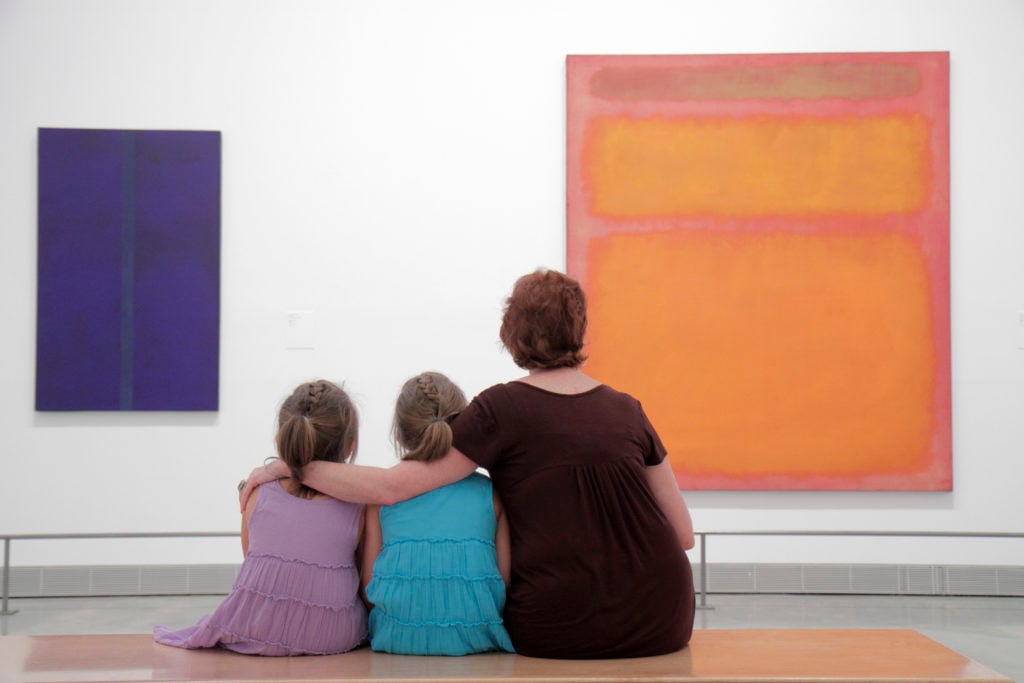
As the art world navigates new frontiers of progressive politics, many parents in the industry feel left behind.

Rachel Corbett


Curator Nikki Columbus made headlines last year when she sued MoMA PS1 for discrimination after the museum’s leadership allegedly rescinded a job offer upon learning that she had recently had a baby. Although the case was ultimately settled out of court this March, the publicity surrounding it brought widespread attention to an often overlooked bias in the art industry—against pregnant women and new mothers.
Some say the discrimination they experience is outright; others say it is more insidious, woven into the fabric of workplaces built under patriarchal conditions that often fail to value men as fathers and mothers as workers.
Despite study after study showing that substantial maternity leave is good for both businesses and women alike, many companies—both within and outside the art world—continue to operate as if less is more. In America today, only 18 percent of working mothers receive paid maternity leave, according to a National Compensation Survey last year. And while mothers lose 4 percent of their hourly wages for every child they have, fathers of the same age and job status see their wages rise by 6 percent, according to a 2014 study from the University of Massachusetts, Amherst.
These problems are amplified in the art industry, which is largely composed of non-profits and small, private businesses that lack human resources departments, and of artists and freelancers (curators, writers, studio assistants) who may receive no benefits at all. While the Family and Medical Leave Act of 1993 gave all employees the right to take up to 12 weeks unpaid, it is not enforceable for employers with fewer than 50 staff members—which accounts for most art businesses and organizations.
And yet, despite its lack of security, the art industry remains competitive, with no shortage of workers who are highly educated, able to travel, and willing to keep up with a demanding calendar of evening events. Quietly, though, many parents are starting to ask themselves the true cost.
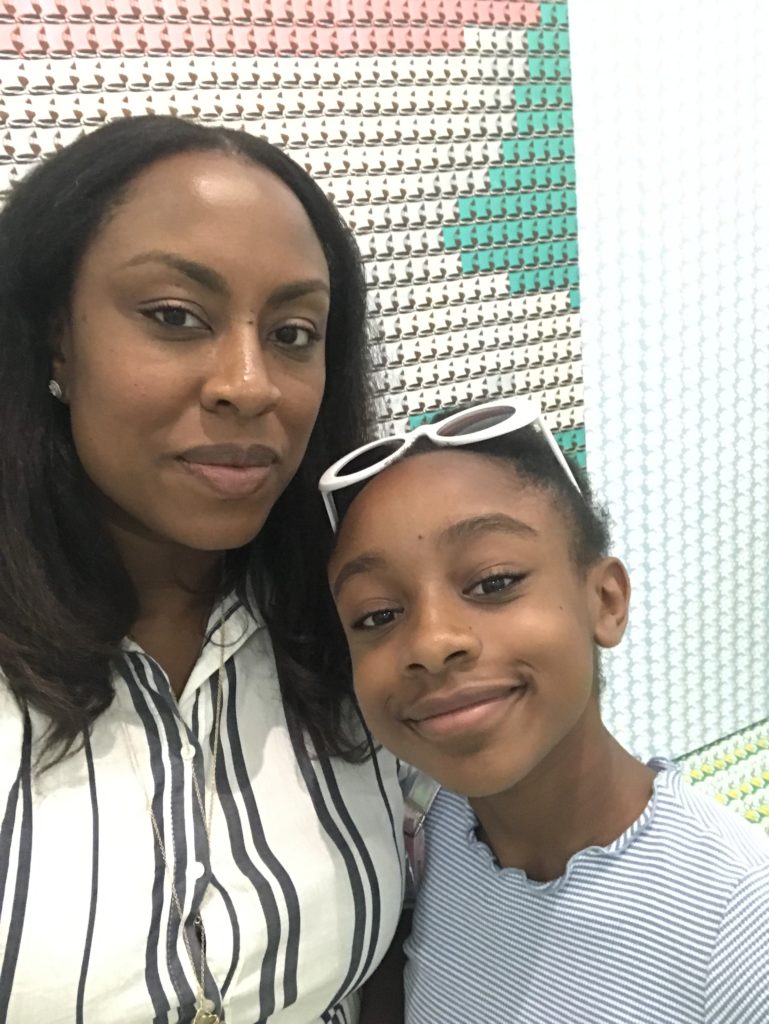
Art publicist Tiana Webb Evans and her daughter Maya at the New Museum.
Researchers note that there are business incentives to offer paid leave and other accommodations to new parents. Studies show that women who receive maternity leave are 93 percent more likely to return to work within a year than those who do not. Turnover rates also plummet when companies offer more generous leave packages.
When Google increased its parental leave from 12 weeks to 18 weeks, for example, it cut by half the rate at which new mothers quit. “When we eventually did the math, it turned out this program cost nothing,” wrote Laszlo Bock, Google’s former senior vice president of people operations, in his 2015 book Work Rules! Insights from Inside Google That Will Transform How You Live. “The cost of having a mom out of the office for an extra couple of months was more than offset by the value of retaining her expertise and avoiding the cost of finding and training a new hire.”
But there are few Googles in the art world. Many larger organizations, such as museums, do have clear parental leave guidelines in place, but the policies vary widely. Benefits also depend on where the business is located, since the rules in London are very different from those in New York or Los Angeles.
The Museum of Contemporary Art in Los Angeles, for example, has the most robust policy of the museums we surveyed, with up to 28 weeks of unpaid leave for mothers and up to 12 weeks for fathers, who can both apply for reimbursement of their full wages from the state.
New Yorkers now have added benefits provided by the New York State Paid Family Leave Act, which took effect in 2018 and applies to private employers of any size. The law requires employers to give new parents 10 weeks of paid family leave at 55 percent of their average weekly wage (a rate that increases to 60 percent in 2020).
At the Whitney, new parents receive four weeks of paid parental leave at 100 percent of their salaries, plus an additional six weeks of paid medical leave. “The Whitney is dedicated to providing opportunities for staff to spend time with their families and loved ones, particularly during critical periods such as the arrival of a new child,” the museum said in a statement.
Nonetheless, these policies are meager compared to those mandated in almost every other developed nation: the time off tallies less than the first three months of a child’s life.
The situation is even worse for the many art workers employed by small and mid-size galleries, which often make up policies as they go, usually not considering it until there is a need. “Maternity leave policy in galleries seems to be uncharted territory for the most part—it’s almost like you have to cross your fingers and hope the gallery is sympathetic,” said Elisabeth Sann, a director at Jack Shainman Gallery. Her employer did not need to create a maternity policy until she got pregnant. In the end, the gallery gave her 12 weeks of paid leave and she used an additional three weeks of sick days and vacation time.
For gallery owners, the situation is tricky. New York gallery owner Rachel Uffner resumed working almost immediately after her child’s birth: “I make all the decisions and content for the gallery so something like taking a strict maternity leave would never be possible,” she said. Nonetheless, as business owner, she has more freedom now: “My working hours are flexible.”
Sean Kelly, too, gave one employee who recently gave birth—his daughter, Lauren—three months fully paid leave, which she considered generous. “Sean is British so he strongly believes in a more European approach to maternity leave (as well a healthcare coverage and retirement plans),” she said. Still, the time off lags behind that offered by European counterparts (in the UK, new mothers are entitled by law to return to their job after a full year off work if they choose; not all of this time is paid).
In other countries, new parents also do not have to negotiate with their employers, a considerably less stressful arrangement. Many in the US art world feel beholden to their bosses. Holly Shen received 12 weeks of unpaid leave at the Brooklyn Academy of Music, where she served as director of visual arts from 2013 to 2018. She recalled feeling “more or less pressured into being available on-call by phone during my maternity leave—a request that in some roles or positions is appropriate but that in hindsight felt a bit exploitative.” By the time she had her second child, in 2017, she had more seniority, and BAM, which had undergone a change in leadership, gave her fully paid leave.
Nevertheless, she said, “the onus is still on women to figure it out for themselves.” Shen notes that her current employer, the San Jose Museum of Art, offers no paid leave for new parents. “It’s painful to be in a leadership position and not see any clear path to achieving this,” she said.
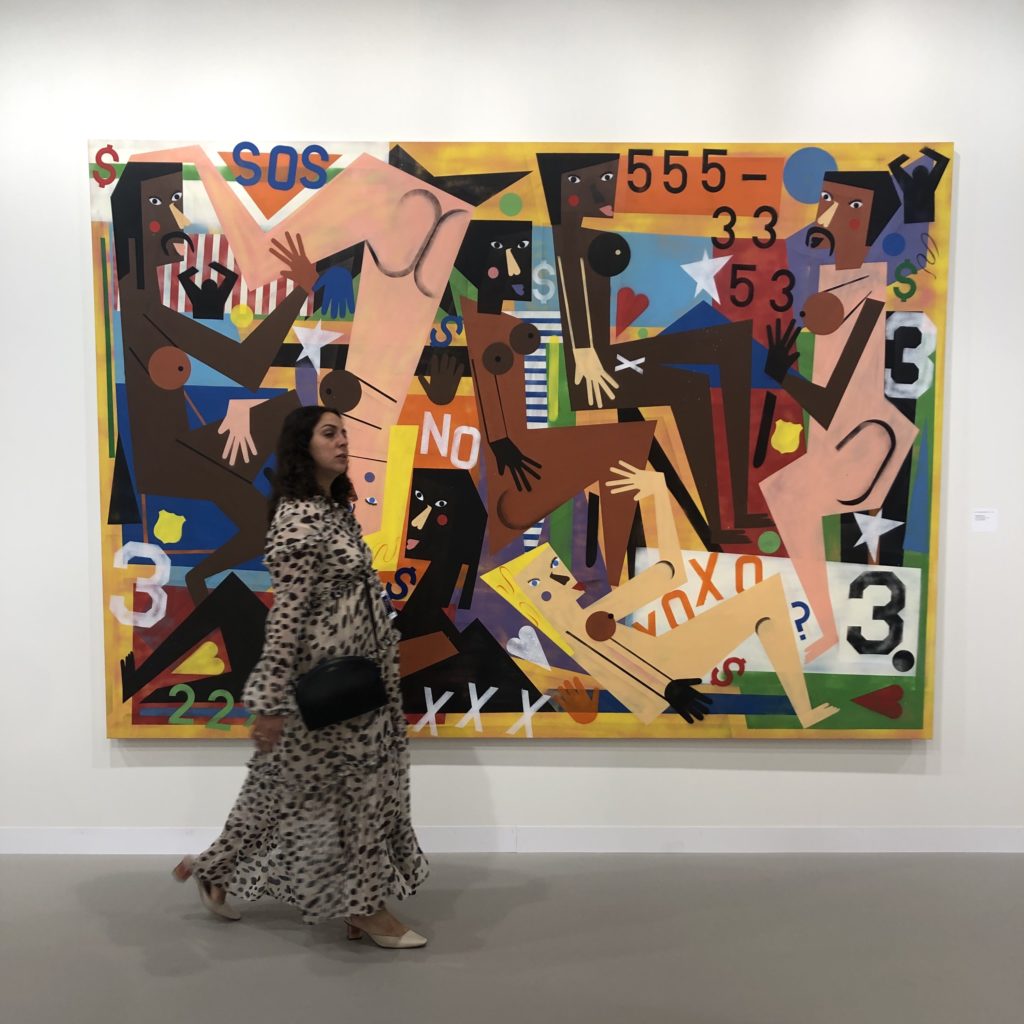
Elisabeth Sann, pregnant with her second child, in front of a Nina Chanel Abney painting at Art Basel 2019.
Many women note that the art industry—which prizes both seeing and being seen—often feels inhospitable to people with families. “We are an industry of vampires because so much of the ‘real’ business happens at night or when you are out of the city on business trips,” said art publicist Tiana Webb Evans, a mother of three.
This can put all parents at a professional disadvantage, with women often disproportionately bearing the burden. “I get incredibly jealous of my male counterpart artists who seem like they can roam forever out into the world because they have a wife at home to take care of the child,” said artist Catherine Opie. She has a son and stepdaughter with her wife, artist Julie Burleigh, and says they share parenting responsibilities 50-50. “It’s not about money, it’s about parenting, and what it is to be a parent is to be present.”
Women who do strive to maintain a public presence often find that the system does’t support them. Elisabeth Sann attended last year’s Art Basel Miami Beach the week after she returned from maternity leave. “Looking back on it, it sounds nuts that I went down there, but I think it forced me to get back into the right frame of mind,” she said. “I may miss out on opportunities because I’m not out there as much as I used to be.”
It was during that fair that she realized she would have to stop breast-feeding—the process was too difficult on the road. “I had tried to call the convention center to see if they had dedicated pumping rooms and couldn’t get an answer, so I would have had to lug the pump and a cooler with ice packs to the fair, probably leave it at the coat check because we don’t build our booths with closets, hope that the bathrooms had an electrical outlet, and then somehow carve out three 20-minute breaks during a fair at which I normally don’t even have the time to eat or go to the bathroom,” she recalled. “Plus, the day extends far beyond fair opening hours. You have breakfast meetings, dinners, parties—you’re out of your hotel room for 18-hour stretches.”
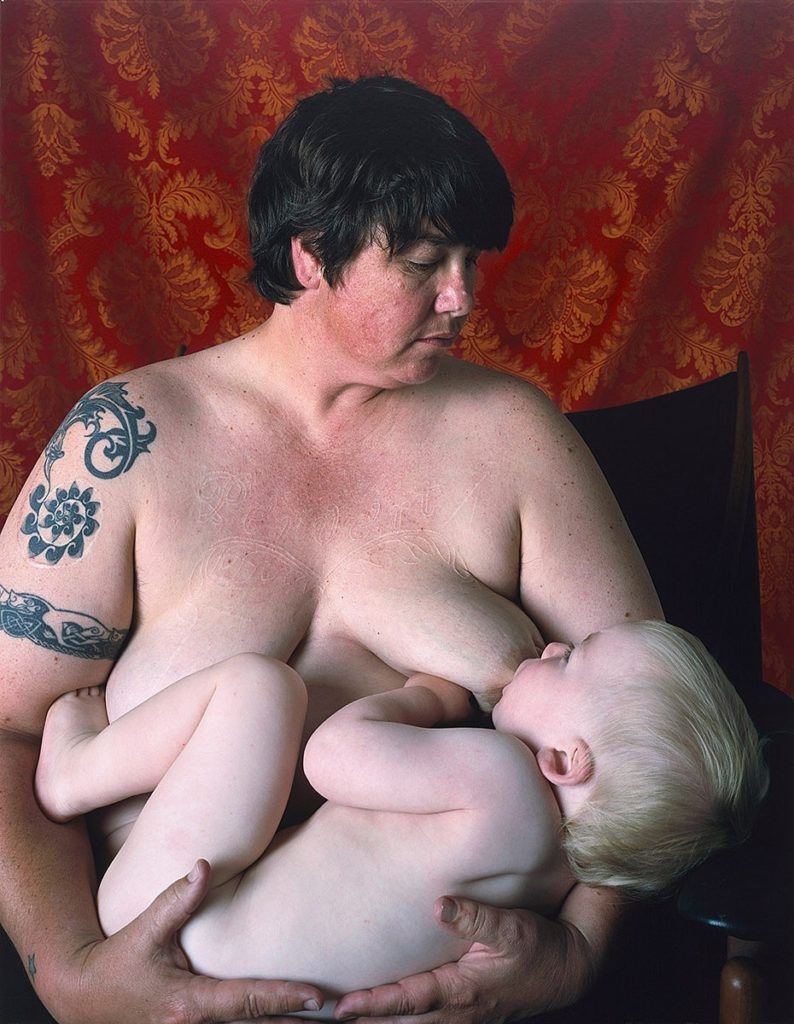
Catherine Opie, Self-Portrait/Nursing (2004). Courtesy of Solomon R. Guggenheim Museum, © Catherine Opie.
Pumping—when to do it and where—was among the most common grievances women interviewed for this story expressed. Those who have not personally breast-fed may have no idea, for example, that it can take hours each day, that it must be done at set intervals, that it can be noisy and messy, and that bathrooms are never acceptable places for a woman to pump or breastfeed.
“I wish I had more information or resources about nursing or support for pumping while working,” said Shen, who felt “resentment and annoyance” from colleagues when she needed to take time to pump.
“I don’t think everybody realizes that when people come back form maternity leave, yes they’re back, but they’re also pumping,” noted Whitney Museum curator Rujeko Hockley, who gave birth to her son in February, in the midst of curating the 2019 Whitney Biennial. “That has to be part of the ways companies look at family policies. The times you pump are set. It’s your internal body schedule, based on when you fed your baby last. There’s actually not as much flexibility as people might think. I actually can’t go any time.”
That’s why Hockley and other new mothers working at the Whitney have created an Outlook calendar to coordinate meetings around their pumping schedules. The museum also has a dedicated lactation room with a sink and a refrigerator. “I know people in the art world who’ve said, ‘I pumped in the broom closet, or the bathroom,’ which is not hygienic,” Hockley said.
That would be illegal nowadays in New York City, which passed a law in 2018 requiring all businesses with four or more employees to provide a room devoted solely to breastfeeding and pumping, and to allow employees the time to do so. But most states and cities do not mandate a lactation-only room in workplaces. Federal US law only requires employers to provide a private space that is not a bathroom, which could mean a manager’s office, an area behind a screen, a supply room, or even a tent.
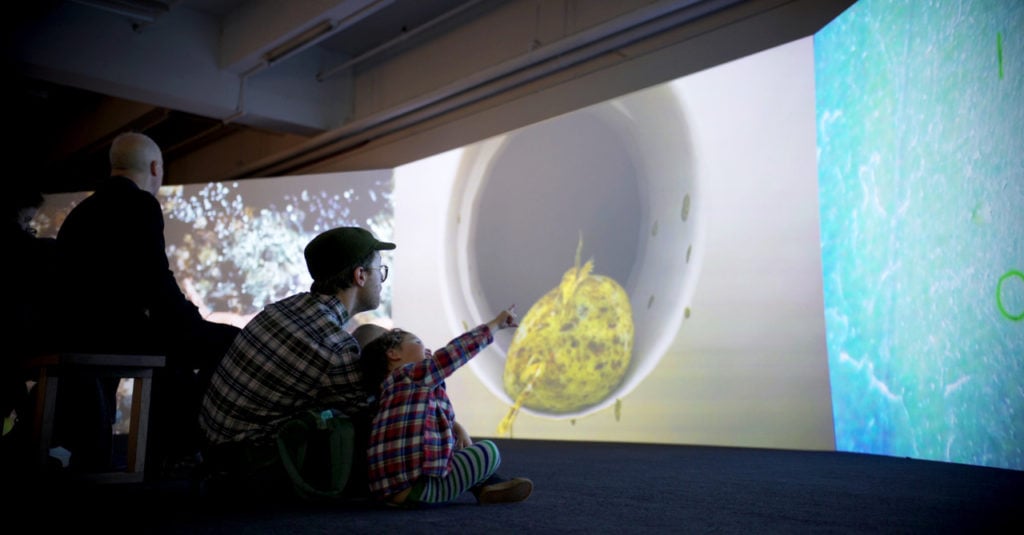
Holly Shen’s partner, artist Jeff DeGolier, and their son, Hewitson Shen-DeGolier, looking at Eva Papamargariti’s Precarious Inhabitants at NADA New York. Courtesy of TRANSFER and Hellions Studio.
Artists, who often receive few or no parenting or healthcare benefits, are among the most vulnerable workers in the industry. In the wake of having children, many report grueling schedules, taking on side jobs that provide a more stable income, and losing time to make art.
“I found it isolating, and the conflict between my son’s needs and my need to work was intense, especially in the early years,” said artist Moyra Davey, who edited the 2001 collection of essays, Mother Reader: Essential Writings on Motherhood. Davey started reading the essays that would later appear in the book after giving birth to her first baby in an effort “to break the isolation, for inspiration to keep going and to do better, for the gratification of seeing my own experience so vividly mirrored,” she wrote in the book’s introduction.
Because artists often do not work a traditional nine-to-five, they also tend to be the ones who compromise when parenting needs arise. “When my children were very young, I would stay home and watch them in the day, working late into the evenings,” said artist Nicholas Galanin, who has six children. “It was a challenge and I ended up often working through dinner until 2 a.m., waking at 7 a.m. to watch them.”
Even the most successful artists describe making career sacrifices to mitigate fears of financial insecurity. “I didn’t want to rely on the art market to make sure I could provide for my family,” Opie said. That’s why she has been teaching for three decades, first as an adjunct and now as a tenured professor at UCLA. “Teaching was always my way to being a parent because if it didn’t work out through the art world then I always had a job with health insurance,” she said.
Now, to help ease the burden on other working mothers, Opie has instituted a kind of bring-your-baby-to-studio policy for her own assistants who have young children. “I knew from being a mom how hard it is just to completely go back to work and turn your baby over to daycare,” she said. That’s why she built a diaper changing area and a baby-friendly zone in her studio for assistants to bring babies that are up to six months old. “It’s worked out great,” she added.
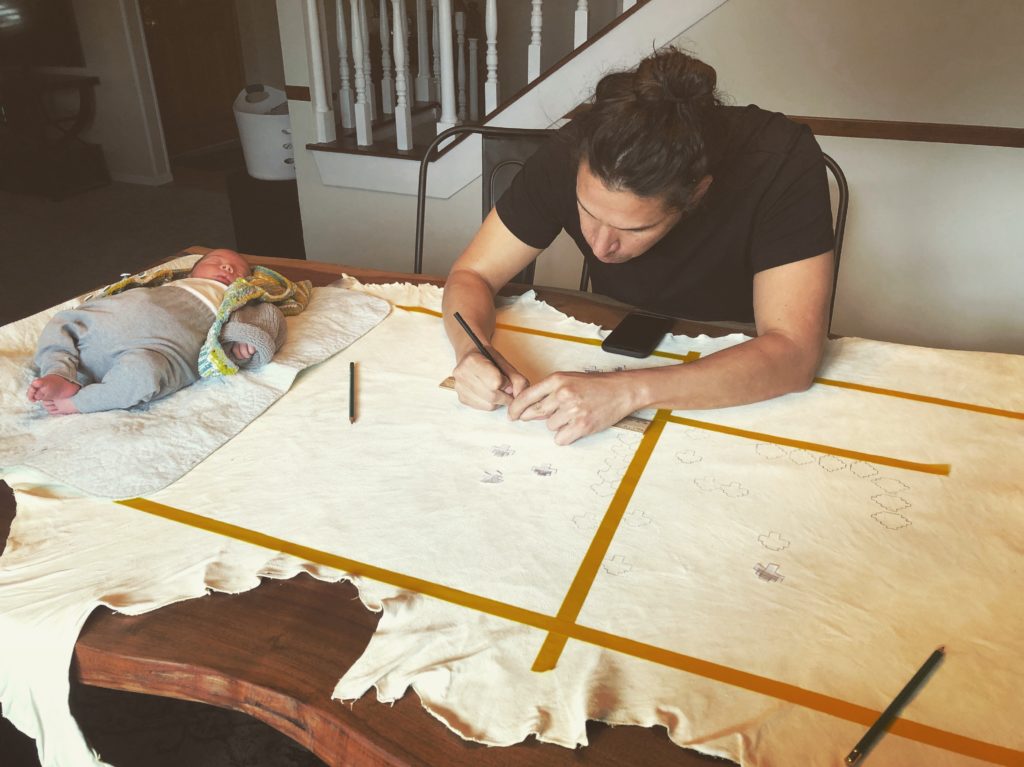
Artist Nicholas Galanin with his baby at his home studio in Alaska. Courtesy of Nicholas Galanin.
No matter how workers in the art industry might creatively balance their families and careers, sometimes the barriers are beyond their control, and pregnancy discrimination remains a serious problem.
Sann recounts seeing first-hand at previous gallery jobs “how pregnant women or mothers were pushed aside or looked over for opportunities. I once heard a gallery owner make a remark to a pregnant woman about how much she was eating, implying she was starting to look a little fat.”
Both federal and state laws in the United States forbid discrimination against pregnant people, and the New York City Human Rights Law singles out caregivers as a protected group as well. (This is not the norm for caregivers in most states, however, including California.) Job-seekers in the US are also not obligated to disclose their pregnancy to would-be employers, which could lead to discriminatory hiring decisions.
That’s a lesson Shen learned the hard way. “I was interviewing for a gallery job and when I disclosed I had a small infant at home I could instantaneously see that the gallerist did not want to hire someone who had to worry about childcare,” she said. “I think the statement was something to the effect of ‘well, this job requires a lot of flexibility in the evenings, which could be difficult for you.’ After that, for a long time, I stopped telling anyone professionally that I was a mother.”
Shen’s account is strikingly similar to Columbus’s allegations against MoMA PS1 last year. In her lawsuit, Columbus said the museum offered her a job as associate curator of performance and that, during the final negotiations over pay and start date, she revealed that she had recently had a baby. The museum’s chief curator Peter Eleey told her, according to her complaint, “Why didn’t you tell me this two months ago?”
A few days later, the museum’s chief operating officer wrote to her: “We are sorry that we are unable to tailor the position on the terms you have proposed.”
Columbus says she is still experiencing fallout from the incident. “When MoMA PS1 discriminated against me, I wasn’t just left without a job, but an entire career path,” she said. “There aren’t a lot of performance curator positions in New York, and they’re generally either too entry-level or require more experience.”
As part of the terms of her settlement earlier this year, she says that the museum “had to commit to critical anti-discrimination guidelines and trainings as well as other policy changes.”
In a statement, a spokesperson for MoMA PS1 said the museum always complied with the law and has not made any changes as a result of the settlement: “MoMA PS1 is committed to a work environment in which all applicants and employees are treated with respect and dignity. We have not, and will not, discriminate in hiring or promotion based on pregnancy, caregiver status, or gender—or any other characteristic protected under the law. Our practices and policies have been at all times compliant with the law. No changes were made to our practices as a result of the settlement.”
The spokesperson did not respond when asked to clarify the discrepancy between the museum’s and Columbus’s versions of the settlement terms. Columbus maintains that she settled “precisely because MoMA PS1 agreed to finally put in place policies that would protect their employees. Whatever MoMA PS1 might claim their practices were, they did not, in fact, have anything written down that would inform employees of their legal rights.”
Today, Columbus is still looking for a job. “I’m not exactly an unknown quantity—I’ve worked as an editor for 20 years, and I think news has spread that I need a job,” she said. “But only one person in the New York art world has approached me about a position.”
This story is part of a research project on the presence of work by female artists in museums and the market over the past decade. For more, see our examination of museums; our examination of the market; four case studies on museums making change; visualizations of our findings; art-world reactions to the data; and our methodology.
UPDATE, September 24: After this article was published Nikki Columbus sent an excerpt from her settlement with PS1 indicating that the museum did, in fact, agree to make changes to its anti-discrimination policies as a result of her lawsuit. The document reads:
“MoMA PS1 agrees that it will revise certain of its policies. These revisions shall include (i) MoMA PS1’s antidiscrimination policies to which it will add the term “applicant” (if it is not already included) and (ii) changes and revision to MoMA PS1’s Policies and Procedures Manual in electronic and hard copy form consistent with the policy revisions that the Parties agreed to during the mediation on February 5-6, 2019. The following policies, which were memorialized in writing during the pendency of this action, will be included in MoMA PS1’s Policies and Procedures Manual: Disability Accommodation Policy, Equal Employment Opportunity Policy (including the Caregiver Discrimination Policy), New York Paid Family Leave Law Policy, Nursing Mothers Policy, Pregnancy Accommodation Policy, Safe and Sick Leave Act Policy, and Family Medical Leave Act Policy. MoMA PS1 agrees to distribute to its employees updated electronic and hard copies of its Policies and Procedures Manual for which MoMA PS1 will solicit employee receipt acknowledgements. MoMA PS1 will also make a copy of its Policies and Procedures Manual available in its break room. Further, MoMA PS1 shall conduct annual training on discrimination and harassment using a qualified trainer of its choice in compliance with New York State and New York City Human Rights Laws.